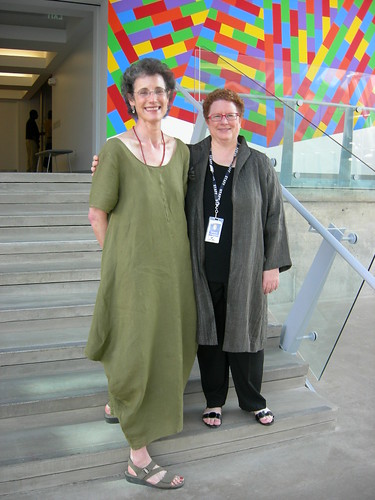Post by Andrea Kirsh

Akron Art Museum, architect–Coop Himmelb(l)au; image © Roland Halbe
People who think that serious art and architecture are only to be found in big cities on either coast are just showing their provinciality. A couple weeks ago I received an invitation to the opening of the new building at the Akron Art Museum, and when my friend Barbara Neswold offered to share the drive, I accepted. This small city (population 217,000) in the mid-west had turned to architects from a small, middle- European country: the Austrian, Coop Himmelb(l)au, which has been among Europe’s most exciting firms since its founding in 1968, a year of massive unrest but also visionary thinking. Philadelphians may remember their design for the installation of the Rudi Gernreich exhibition at the ICA in 2001. Akron’s coup is Coop Himmelb(l)au’s first U.S. building, and it is stunning.

Akron Art Museum, image © Roland Halbe
What they produced is the most exciting structure I’ve seen since Gehry’s Disney Concert Hall in L.A. It is also the most successful museum expansion I’ve visited since Raphael Moneo’s un-sung gem of an addition to the Davis Art Center at Wellesley (note: I have not yet seen Steven Holl’s recent addition to the Nelson-Atkins in Kansas City; the mostly subterranean building looks like a great solution).

Akron Art Museum, image © Roland Halbe
The brief was threefold: to enhance the museum’s reach in the community, to provide additional display space and to act as a catalyst for further revitalization in downtown Akron. Their choice of adventuresome European architects was brave and ambitious, and they scored on all three goals. The building’s front is an unfolding accordion of glass which creates a conservatory-like space nestled beneath the dramatic cantilever of a steel grid. This forms part of a soaring roof-line which extends over the museum’s old building (an 1899 Renaissance revival structure in brick, built as a post office) and projects in four directions. This steel “roof cloud” performs rather like a conspicuous hat: it provides some shelter from the sun but primarily it attracts attention and makes a statement of style. The distinctive roof is visible when approaching the museum from all directions. Not that it isn’t functional as well: one of the projecting wings houses the HVAC system.

Our correspondent Andrea Kirsh with director, Mitchell Kahan in the lobby of the Akron Art Museum’s new building; photo by Barbara Neswald, special to artblog
The design makes it clear that the lobby is a public space and an exciting one. After all, these are architects who say that the major models for their thinking are the Rolling Stones and Keith Richard. This dynamic space, contiguous with the street, beacons pedestrians to enter and see what’s behind; and what’s behind are well-proportioned, neutral spaces that would be any curator’s dream, filled with a truly impressive collection. I started with earlier work housed in the old structure and discovered an eye-opening collection of mid-20th-century artists from Ohio. If the names of William Sommer, Elmer Novotny and Carl Gaertner aren’t as well-known as Kenneth Hayes Miller, Everett Shinn and Alexander Hogue, they should be – and discovering them is just one of the benefits of venturing inland.

Victor Schreckengost “Transportation” costume for Akron Art Museum Rubber Ball 1938-39
My absolute favorite was a costume design by Victor Schreckengost, who’s better known for his commercial and industrial work. The costume was for the museum’s annual fund-raiser which still provides most of the acquisition funds: the Rubber Ball (a reference to the city’s major industry at the time); it featured trucks and other vehicles circling the wearer’s hips, and had all the panache of a stage set for a Busby-Berkeley dance number

The new galleries house Akron’s contemporary work, a collection whose high quality reflects the fact that the museum has been able to purchase much of it (thanks to those balls), rather than relying on the vagaries of local collectors and their annual tax status. They have a seminal early Chuck Close (“Linda” 1975-6) but also an important early installation by Doris Salcedo: “Atrabiliaros” 1996, a tremendously-moving group of wall niches, each filled with shoes then covered with what looks like translucent human skin (actually cow’s bladder), hand-stitched to the walls. Salcedo was referencing the disappeared in her native Columbia, but the piece has a tragic resonance with numerous twentieth-century atrocities.
The museum featured a group of recent photography purchases where the museum had the wisdom to collect sufficient numbers of each artist’s work, rather than the more common one-by-each. The international list included Vito Acconci, Dieter Appelt, Samuel Fosso, Gilbert and George, Isaac Julien, Thomas Struth and Carrie Mae Weems (the last is an artist I worked with, and this may be the largest museum assembly of her work).

the Akron Art Museum’s colorful giftshop, staffed by Pat Simmons, Angela Nakovoska and Laura Firestone; photo by Andrea Kirsh, special to artblog
Neighborhood revitalization has already begun, if our lunch at a restaurant across the street is any indication. Crave’s stylish design and nouvelle menu wouldn’t be out of place on either coast; the only thing provincial were the prices. Eight years in the planning, the new museum resulted from a campaign called “Create A Masterpiece.” That the staff were still there, and all of them smiling, is a testament to the community and the museum’s leadership. And the new building certainly lives up to it’s high ambitions. Hurrah for Akron!
–Andrea Kirsh is an art historian based in Philadelphia. You can read her recent Philadelphia Introductions articles at inLiquid.






